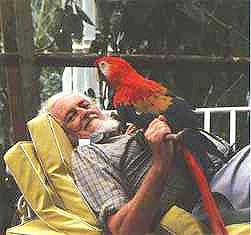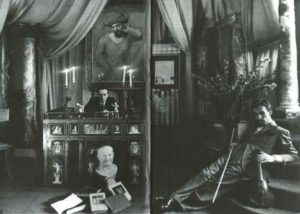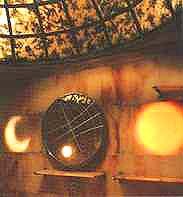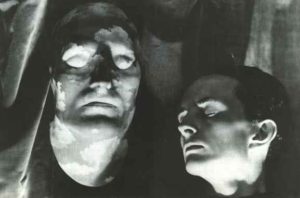We jounce for five hours in a pickup truck heading west from Tampico over the dusty Mexican plain to the Sierra Madre, up and up into a green world-peaks as sudden as the mountains of Moorea, tree-covered jagged ranges huge enough to be the molars of God, past coffee plantations, ramping bougainvillea, banana trees, crashing streams-and on to the very top, through the steep hilltop town of Xilitla to reach at last the hidden city that Edward James, the eccentric British Surrealist, built in the deepest jungle, a swirling dream in concrete, a fantasy of shapes that marries Gaudi, Escher, Borromini, Simon Rodia and the Emerald City of Oz.
With my guide I slip through the gate of this amazing place, called Las Pozas after its nine pools strung along a winding jungle river, connected by waterfalls. I climb a 20-foot concrete cactus, Up freestanding steps to a mushroom platform, up again on spiraling stairs that finally wind themselves around the great shaft and disappear. Enormous fluted columns all around. Eight-foot walls with teal shaped holes, a moongate, a path bordered by erectile mosaic serpents. Great gates framed in wrought-iron stars. Concrete leaves big enough to walk on, bulbous concrete flowers in yellow, red, green, blue, white, purple. Gourd shapes. Calabash shapes. Dolphin shapes. Stairs that lead straight up into space and stop. With its raw concrete patinaed by green mildew, rusting corrugated steel and neglected stretches of fence bent by fallen trees, Las Pozas feels like a Sleeping Beauty castle arrested in time before it was quite finished.
A gazebo here, and close by, a tiny apartment four stories up with glass windows, two freezers, a fireplace, archways, glass bricks and a collection of perfume bottles. Ferns everywhere, lianas, thickset trees, all so intertwined with the constructions that it is impossible to tell where the jungle leaves off and the invention begins. Tucked into the steep hillside, I find a storeroom crammed with the beautiful wooden molds made by local carpenters for all these fantastic shapes. Also James’ four-man sedan chair. And a stone hand nearly as tall as a man. Beside it, a nine-foot dome, almost an Olmec head, beset with columns that blossom out on top, and more bamboo-like columns, so delicate that they quiver when a bird takes off from them. Some of the fantasies have names: the House With a Roof like a Whale, the House With Three Stories That Might be Five, the Stegosaurus Colt, the Fleur-de-Lys Bridge and Cornucopia, the St. Peter and St. Paul Gate, the Temple of the Ducks, the House Destined To Be a Cinema.
The waterfalls, especially the biggest one, more than 80 feet high, are embellished with platforms, curving walls, flying buttresses that may hold up the entire hank or may do nothing at all, battlements, mysterious little prows jutting into the pools. The lower pools have diving boards and small sandy beaches for the local people who come here to swim.
Everywhere, underfoot and up wall corners and winding around concrete bamboo screens, I see electric conduits. In 1979, when the place was as nearly complete as it ever would be, James had lines brought in from Xilitla and lit up the mountainside like a fairyland every night.
Talk about magic. Everyone in town came to see. Las Pozas was locally famous, of course. It had been abuilding since 1949, and from 1962 on, employed as many as 150 workers at one time. By the time he died, in 1984, James had sunk millions into the project. Here and there, snug among the six-foot-thick columns (designed eventually to support enormous planters and an aviary) and barrel vaults and groined arches and framed windows, I noticed all sorts of cages. A little aviary for parrots and flamingos, a screened cage for the ocelots, a deer corral, a two-story room for small monkeys, a turtle pool, a 20-foot concrete pool shaped like a human eye, its pupil five feet across. This was where the crocodiles often played, our guide mentioned casually.
Edward James adored animals. When he visited Mexico City he always stayed at the elegant but modest old Francis Hotel or the Majestic, because they let him keep his animals there. Once a guest complained that there were mice in the hotel. She was sure she had seen one in the hall. The manager replied, “Oh no. They’re not the hotel’s mice. They belong to Mr. James in the room next to yours. He feeds them to his boa constrictors.”
James often wandered through his jungle home with a parrot perched on his shoulder. Once he showed a young friend how his beaky nose and pointed chin were growing closer together. He said, with a certain complacency “I am turning into a parrot, you see.”
Eccentric
Las Pozas is strange, but not half as strange as its creator. His American grandfather, already a millionaire with vast timber holdings, married into the mining wealth of the Phelps Dodge family before moving to England. One of his three sons, who made his career as the master of West Dean Park and its 6,000 acres in Sussex, married an Englishwoman who was reputed to be an orphaned daughter of Edward Vll.
Edward James was born to them in 1907, into a world of nannies and shooting parties, shuttled seasonally between West Dean, his parents’ London town house in Bryanston Square, and a summer place in Scotland. He went to Eton, and hated it. At Oxford he had a Rolls-Royce and a silk-lined room worthy of a Sebastian Flyte, and he soon drifted into the gilded London society of Sitwells, Mitfords and Cunards, of Noel Coward and John Betjeman, of Agustus John and Randolph Churchill.
A charming person, Edward James was a wonderful raconteur and a lover of parties. His hermetic childhood left him curiously innocent about the world of work. And impulsively generous: once when a friend wanted to borrow his car, he gave it to him. But then a reaction — “They want my money, they want my blood” — and he would retreat into introversion.
He was a packrat who never threw anything away, and so obsessively fastidious that he would boil up a saucepan full of old paperclips, drenched in cologne, for reuse. Named to a diplomatic post, he almost caused an incident through his insouciant mistranslations and was fired. He wrote poetry and printed it himself, wrote a novel or two, fell in with avant-garde artists and then, in 1928 met Tilly Losch.
She was dancing in a Noel Coward revue but was celebrated more for her sinuous, wanton beauty than for her dancing. She filmed a performance piece that featured her lovely hands sinuously interlacing to Bach’s “Air on a G String.” James married her. He was 24. Soon it turned out that she had fancied a marriage in name only (it happened in those days). She involved herself in a series of increasingly visible affairs, including a primal scene on a sofa with Randolf Churchill witnessed by a maid, and finally left him. To get he back James financed George Balanchine’s first company, Les Ballets 1933, paying for three ballets for her, including the landmark Brecht-Weill collaboration “The Seven Deadly Sins,” performed by Tilly Losch and Lotte Lenya, and another ballet with music by Darius Milhaud and sets and costumes by Andre Derain.
It was no use. Tilly sued for separation, charging homosexuality among other things, whereupon James scandalized everyone by countersuing, accusing her of adultery with Prince Serge Obolensky. Astonished and wounded by the outcry, for this simply was not something a gentleman did, James moved to Europe for a while.
There he met Salvador Dali and was so taken by him that he contracted to buy all his work for a year and to subsidize Dali’s “Dream of Venus” exhibit for the 1933 New York World’s Fair. He was already buying Picassos, and that same year, 1937-38, he patronized Rene Magritte and joined the Surrealist movement in earnest.
“La Reproduction Interdite,” the famous Magritte painting of a man shown from behind as he looks into a mirror and sees the same back of head, is a portrait of the back of Edward James’ head. He is also the model for the head-as-explosion-of-light portrait Pleasure Principle, though one can hardly tell.
Personally, Surrealism is not my cup of fur. But in James’ case, the question does come up: How does it differ from sheer eccentricity? I think the difference is that Surrealism has purpose. It seeks to shock the viewer into a new way of seeing. Andre Breton wrote, “The marvelous is always beautiful, anything marvelous is beautiful, there is only the marvelous that is beautiful.”
James had Tilly’s bare footprints woven into the stair carpet at West Dean. He had wooden moldings in the shape of towels hung out beneath the windows of Monkton House, his Surrealist country home. There too stood the original Dali sofa made in the shape of Mae West’s lips, in addition to Dali’s first lobster-telephone, designed for James, as were the Giacometti andirons. And mock-bamboo drainpipes, wooden palm trees, a boa constrictor lamp, pawmarks of Edward’s Irish wolfhound on the stairs, a bathroom with walls of translucent alabaster and a medicine cabinet disguised as a bookcase. Surrealism is about Things. The Surrealism of Edward James, born into a world absolutely cluttered with expensive things and yearning to be free of their magnetism (when periodically overwhelmed by stuff that he accumulated, down to old matchboxes, he would simply have it all wrapped in bushels of tissue, packed in trunks and stored in a warehouse), has a blithe humor tinged with disdain that I sensed often in Las Pozas.
It is impossible to write about the man without dropping names, for one of his great talents was meeting people. It helped to be a rich patron of the arts. While still at Oxford, he founded the James Press for the debut of John Betjeman’s poems and his own. Later Betjeman, as British poet laureate, wrote a poem about his friend, “Surrounded by Bells,” which appeared in the New Yorker: “The Sun that shines on Edward James / Shines also down on me….”
Names
Edith Sitwell introduced James to Dylan Thomas, whom he sponsored for a while; through Dali he met Sigmund Freud and Steven Zweig; as a regular at Surrealist gatherings he knew Leonora Carrington, Paul Delvaux, Pavel Tchelitchew and others; he sublet a house in Rome to Garbo and Stokowski; he commissioned works by Stravinsky and Poulenc. During World War II, he came to America, a visit which took him to Taos, New Mexico, where he met D. H. Lawrence and entourage, including Aldous Huxley. In 1940, Huxley became his ticket to the pantheistic crypto-Hindu Vedanta movement in Hollywood and super chic Ojai, where he met all sorts of people, from Krishnamurti, the great spiritual leader who would not lead, to the major movie stars and directors of the day (including, I note, that other builder of unlived in cities, Cecil B. DeMille) and friends of the great Surrealist filmmaker Luis Bunuel, and on beyond movies to Hollywood’s expatriate writers, such as Thomas Mann, Somerset Maugham, Christopher Isherwood and Gerald Heard, and on beyond writers to psychiatrist Erich Fromm.
Then Fromm invited him to spend some time at the American colony in Cuernavaca, Mexico. The country delighted Edward James. It was everything that England wasn’t: no censorious social critics, none of that upper-class British inhibition, a concept of time that made this habitual maunderer seem punctual and, best of all, a climate that allowed one to grow plants and animals in lush profusion. For his wealth had become a burden and a source of something close to paranoia : more and more, people were besieging him for money, wheedling and conniving and suggesting worthy projects. One French composer’s wife noted in her diary, “Edward James has arrived with his Rolls-Royce, his Duesenberg and, let us hope, his checkbook.”
All through his life he doled out money freely to painters and writers, Surrealist or not, even as he built clinics for poor nuns, bought houses in Hollywood and Malibu and land in Mexico, came to the financial rescue of Rodia’s Watts Towers and supported platoons of hangers-on. No wonder he preferred animals and plants.
Specifically, it was orchids that first brought him to Xilitla. It was by far the best place to grow them, he was told. He met his friend Plutarco Gastelum, part Yaqui Indian, part Spanish aristocrat and a swashbuckling former rancher, boxer, telegrapher and amateur architect, in a telegraph office in Cuernavaca, where Gastelum, taking James for a poorly dressed tourist complete with cheap silver watch chain, had directed him to the second-class bus stand.
“Oh no, thank you,” James replied politely, “I have my car.” Whereupon his chauffeur drove up in a Lincoln Continental. In any case, James hired Gastelum as his manager, and later sent him and his wife, Marina, on a tour of Europe.
In 1962 a once-in-a-lifetime frost killed James’ orchids by the thousands. Crushed, he decided to recoup in concrete. He would build a city of flowers four stories high that no frost could ever kill. Meanwhile, Gastelum, inspired by Venice and Florence, had started to vastly expand his own house in the village of Xilitla. James came to live there with Plutarco and Marina, their daughters and their lively son Plutarcito, now known to one and all as “Kako.” The two great structural follies rose at the same time, influenced by each other.
“I think Uncle Edward was a little jealous of my father,” Kako says. “Sometimes he copied ideas he saw here in our house.” And no doubt Plutarco imitated his rival too: just inside the gate is a series of stepping stones in the shape of bare feet. The feet are splayed and misshapen like James’ own feet, for according to his story he was nearly crippled in childhood by his mother’s refusal to buy him big enough shoes.
While James was alive, the Edward James Foundation, which he had set up in 1964 and which ran the West Dean College of art and antiques restoration, supported Las Pozas. But after his death, major support stopped. James had willed the property to Kako and his sisters. At one time, state officials expressed interest in buying Las Pozas and making it a state park. The locals already use the pools freely, as James had urged them to, and patronize a little cafe on the site. But decisions seem far off at the moment. For one thing, all those protruding steel rods will have to be expensively cut off and capped soon or the structures will disintegrate, an unthinkable tragedy in the mind of the young man who calls James “Uncle Edward.”
Money to indulge every fancy
Early pictures of James show a slight, trim, neatly handsome man with deepset eyes and a firm chin, but Kako knew him as a bent old Robinson Crusoe, distinctly overweight, with a white beard and a stick, with gnarled feet and the money to do any wild, delightful thing that occurred to him, who lived in this house and talked of the grand, thrilling world outside. James died at 77 of a stroke on a return visit to Europe in 1984.
Las Pozas, Kako, his father and a large cast of characters from James’ life figure in the full-length documentary produced by filmmaker Avery Danziger and his wife, Lenore, who worked on it so long that they had had time to fall in love with Xilitla and bought property there. The film is called Edward James: Builder of Dreams.
It is remarkable for its priceless record of Las Pozas with James himself guiding the camera about the premises, talking a steady stream — and for the portrait it draws of this engaging, driven man. Friends from all over the world, from actress Ruth Ford to Leonora Carrington to James Bridges, describe James and his life, only to be topped by the master storyteller, James himself, with his deadly ear for accents. He recalls his stately, remote mother who, on her way to church, would ask a servant to send down one of the children from the nursery, ”whichever one will go best with my blue dress.”
He tells one interviewer, “I used to have to stay in bed long after the sun had risen, until my nanny got up and dressed me. The sun would rise early, especially in Scotland in August, and I would long to get up and play on the beach. So to amuse myself in bed, aged 6, I would turn the sheets into a great hall and the pillows into towers.”
His accent slips easily from hard-edged American to fluty upper-class British. He talks of his animals: the giant butterflies that he named after couturiers Dior, Schiaparelli and Chanel (“the rather dull one in good taste”), the three boas, the parrots, the kinkajous, the ocelots, the ducks and deer and peacocks, the generations of dogs and cats and the four baby crocodiles a friend gave him, one of which “used to sleep in my bed and crawl across and rest his muzzle on my shoulder.”
All of James’ life, I came to understand, was a search for something to create. His novels never amounted to much, his poems were spangled with good lines but also derivative ones and downright bad ones. It was never enough to support other artists or even to appear in their work. The animals had to be returned to the wild. The exotic flowers with which he hoped to brighten the world would die all too quickly. It was in Las Pozas that he found at last his true artistic medium.
It was of heroic scale, it covered acres of jungle, it was a world. Its bare reinforcing rods yearned upward as if they would grow still more columns and platforms in the sky, expanding forever.
Yet the strangest thing of all was the apartment that this unworldly accumulator of worldly things, this owner of land in England and America and Mexico, of houses from California to Scotland, built for himself in the leafy heart of his vast fantasy. The apartment has a bedroom, living room and porch on two stories. On one wall is scrawled in pencil his poem “This Shell”: “My house grows like the chambered nautilus….”
And it is tiny, a doll’s tree house, the smallest possible shell where a man could hide.
(You will find Xilitla, Hidalgo on 26 2-C in the Guia Roji Map of Mexico.)
Edward James — Builder of Dreams
A Documentary Film
By Avery Danziger









